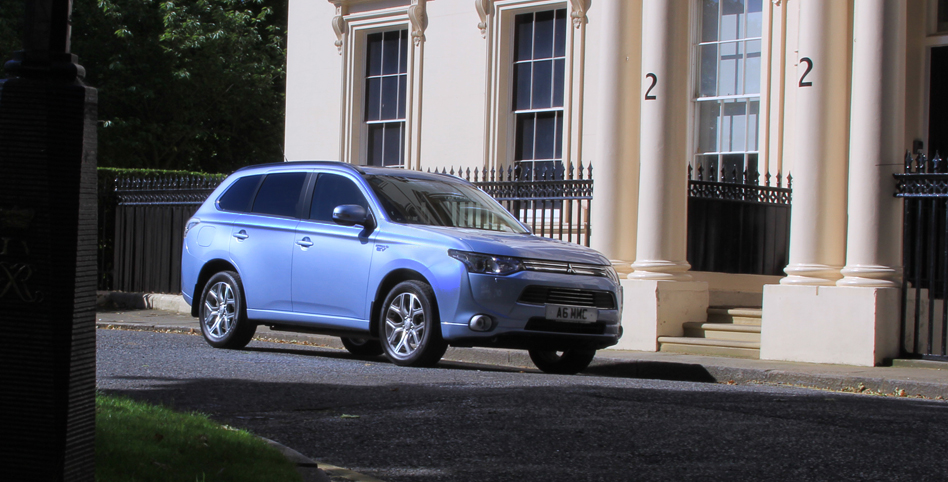By Jay Khan, November 10, 2014
★★★★★
Quick Facts
Model spec: Mitsubishi Outlander PHEV GX4h Price: £32,904.00 Engine: 2.0-L petrol-plugin-hybrid
BHP / Torque: 119 / 190 Max Speed: 106 CO2: 44g/km 0-62mph: 10.6 seconds
Economy/Range: 65mpg combined Tax: £0/year
“you have to understand one thing about hybrids, all hybrids, they are designed to reduce the C02 emissions footprint and not necessarily to improve fuel economy. If you understand that then you begin to realise hybrids are no more efficient than diesel cars.”
The first few days of driving were spent making short, urban trips which totaled 100 miles, all of these miles were covered under pure electric power and no fuel was consumed. And I could have spent the rest of the week using nothing but the national grid to power my daily comute. Recharging the Outlander didn’t cause any problems because there was always a power supply readily available. The batteries did take a couple of hours too fully charge but you also have an option to fit a super-fast recharging unit at home, which costs an extra £2,000. The combined economy on electric power alone was averaging 77mpg. For long haul drives the 2.0-litre petrol engine assumes command, there was an initial doubt as to whether this particular engine had enough torque too haul around the extra 195kg weight gain due to the addition of all that electric technology. But it proved otherwise, if only just. The petrol engine’s acceleration is boosted by the electric motors assisting with the power delivery and you will never notice the interaction when the two powerplants combine because they seamlessly work as one. The batteries are also charged on the move through coasting or braking, but you can also use the on board generator to recharge the batteries at the flick of a switch, whether you are cruising on the motorway or sitting still in traffic. This give’s the Outlander PHEV a small but significant advantage over non-plugin hybrid vehicles which have comparatively short burst’s of electric drive of around 1.5 miles and can only be recharged through kinetic energy recovery. The suspension is stiff, one presumes to cope with the extra hybrid girth, and this can be felt most when driving at low speeds, over potholes or speed bumps. Overall the ride and handling is competently good, crucially its comfortable on a cruise and can handle it self well on twisty B-roads, the electric steering is well calibrated and grip seems plentiful. For the most part many owners will not be thinking of sports car levels of ride and handling for a big 4×4 SUV especially one which has zero tax liability whether it be for corporate or private needs.“the Outlander PHEV and the underlying technology is impressively conceived and executed.”
If you decide to venture off road the Outlander PHEV equips itself well, although if you want a real off-road mud plugger go for the diesel variants because of they offer better low to mid-range torque levels. The Outlander PHEV range starts at £27k and goes up to £34k this includes a £5k government backhander for being so environmentally friendly. Three trim levels are on offer, GX3h, GX4h and GX4hs technically its 4 if you include the 4Work Commercial variant. All models are well equipped the GX4hs was fitted with dual-zone climate control, cruise control, electric windows, remote central locking, Bluetooth connectivity, a USB port, a six-speaker stereo, electric heated mirrors, leather interior, automatic lights and rear parking sensors. You can look at the Outlander PHEV as two cars for the price of one. But you have to understand one thing about hybrids, all hybrids, they are designed to reduce the C02 emissions footprint and not necessarily to improve fuel economy. If you understand that then you begin to realise hybrids are no more efficient than diesel cars. Which isn’t a bad thing. However the Mitsubishi PHEV does buck the trend for fuel “eco-nomists” , but like all hybrids it isn’t the concept that is in question because the concept works flawlessly, it’s the battery technology that needs improving in order to extend the electric powered range. Battery technology is still relatively under-developed compared to these latest hybrid cars and if you talk to any theoretical scientist they will tell you that good old fashioned petrol is still way more efficient, “but pollutes like hell”. Having said that the Outlander PHEV and the underlying technology is impressively conceived and executed.







